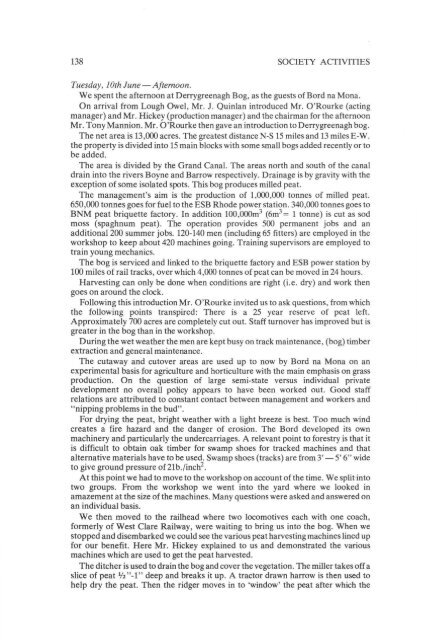Download Full PDF - 28.68 MB - The Society of Irish Foresters
Download Full PDF - 28.68 MB - The Society of Irish Foresters
Download Full PDF - 28.68 MB - The Society of Irish Foresters
You also want an ePaper? Increase the reach of your titles
YUMPU automatically turns print PDFs into web optimized ePapers that Google loves.
138 SOCIETY ACTIVITIES<br />
Tuesday, 10th June-A!temoon.<br />
We spent the afternoon at Derrygreenagh Bog, as the guests <strong>of</strong>Bord na Mona.<br />
On arrival from Lough Owel, Mr. J. Quinlan introduced Mr. O 'Rourke (acting<br />
manager) and Mr. Hickey (production manager) and the chairman for the afternoon<br />
Mr. Tony Mannion. Mr. O 'Rourke then gave an introduction to Derrygreenagh bog.<br />
<strong>The</strong> net area is 13,000 acres. <strong>The</strong> greatest distance N-S 15 miles and 13 miles E-W.<br />
the property is divided into 15 main blocks with some small bogs added recently or to<br />
be added.<br />
<strong>The</strong> area is divided by the Grand Canal. <strong>The</strong> areas north and south <strong>of</strong> the canal<br />
drain into the rivers Boyne and Barrow respectively. Drainage is by gravity with the<br />
exception <strong>of</strong> some isolated spots. This bog produces milled peat.<br />
<strong>The</strong> management's aim is the production <strong>of</strong> 1,000,000 tonnes <strong>of</strong> milled peat.<br />
650,000 tonnes goes for fuel to the ESB Rhode power station. 340,000 tonnes goes to<br />
BNM peat briquette factory. In addition 100,OOOm 3 (6m 3 = 1 tonne) is cut as sod<br />
moss (spaghnum peat). <strong>The</strong> operation provides 500 permanent jobs and an<br />
additional 200 summer jobs. 120-140 men (including 65 fitters) are employed in the<br />
workshop to keep about 420 machines going. Training supervisors are employed to<br />
train young mechanics.<br />
<strong>The</strong> bog is serviced and linked to the briquette factory and ESB power station by<br />
100 miles <strong>of</strong> rail tracks, over which 4,000 tonnes <strong>of</strong> peat can be moved in 24 hours.<br />
Harvesting can only be done when conditions are right (i.e. dry) and work then<br />
goes on around the clock.<br />
Following this introduction Mr. O 'Rourke invited us to ask questions, from which<br />
the following points transpired: <strong>The</strong>re is a 25 year reserve <strong>of</strong> peat left.<br />
Approximately 700 acres are completely cut out. Staff turnover has improved but is<br />
greater in the bog than in the workshop.<br />
During the wet weather the men are kept busy on track maintenance, (bog) timber<br />
extraction and general maintenance.<br />
<strong>The</strong> cutaway and cutover areas are used up to now by Bord na Mona on an<br />
experimental basis for agriculture and horticulture with the main emphasis on grass<br />
production. On the question <strong>of</strong> large semi-state versus individual private<br />
development no overall policy appears to have been worked out. Good staff<br />
relations are attributed to constant contact between management and workers and<br />
"nipping problems in the bud".<br />
For drying the peat, bright weather with a light breeze is best. Too much wind<br />
creates a fire hazard and the danger <strong>of</strong> erosion. <strong>The</strong> Bord developed its own<br />
machinery and particularly the undercarriages. A relevant point to forestry is that it<br />
is difficult to obtain oak timber for swamp shoes for tracked machines and that<br />
alternative materials have to be used. Swamp shoes (tracks) are from 3' -5' 6" wide<br />
to give ground pressure <strong>of</strong> 21b./inch 2 .<br />
At this point we had to move to the workshop on account <strong>of</strong>the time. We split'into<br />
two groups. From the workshop we went into the yard where we looked in<br />
amazement at the size <strong>of</strong> the machines. Many questions were asked and answered on<br />
an individual basis.<br />
We then moved to the railhead where two locomotives each with one coach,<br />
formerly <strong>of</strong> West Clare Railway, were waiting to bring us into the bog. When we<br />
stopped and disembarked we could see the various peat harvesting machines lined up<br />
for our benefit. Here Mr. Hickey explained to us and demonstrated the various<br />
machines which are used to get the peat harvested.<br />
<strong>The</strong> ditcher is used to drain the bog and cover the vegetation. <strong>The</strong> miller takes <strong>of</strong>f a<br />
slice <strong>of</strong> peat '12 "-1" deep and breaks it up. A tractor drawn harrow is then used to<br />
help dry the peat. <strong>The</strong>n the ridger moves in to 'window' the peat after which the

















